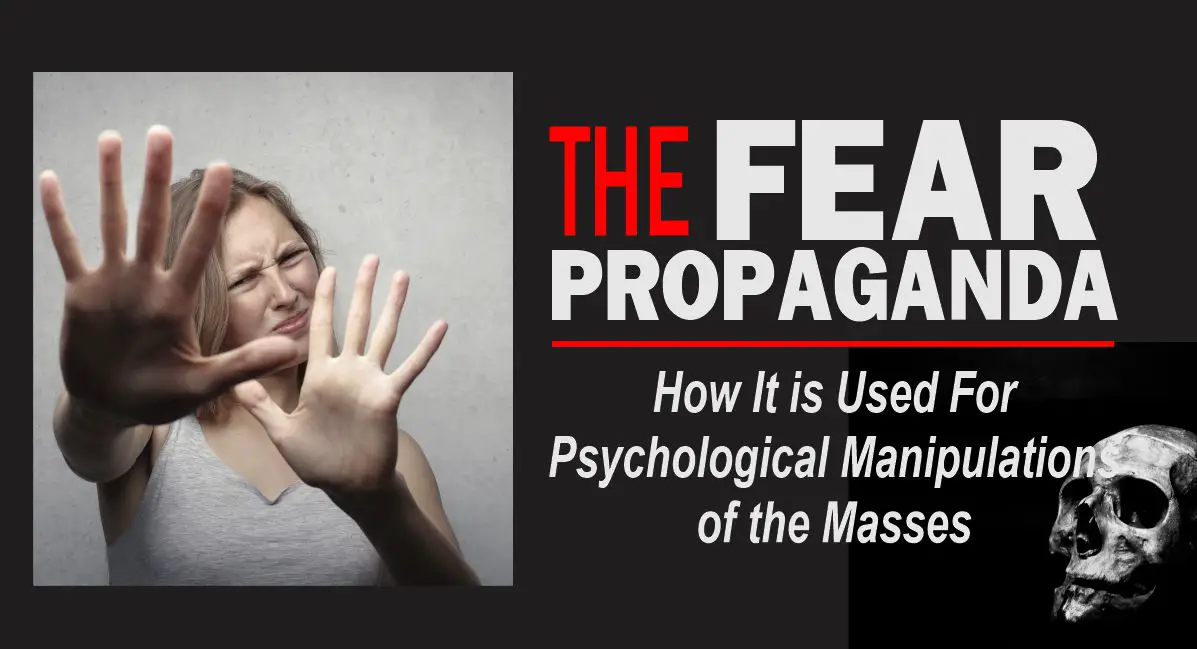Last updated on December 7th, 2025 at 05:39 pm
Fear is an emotion, a tool for manipulation on a large scale and fear propaganda is a convenient vehicle for this purpose. Here is everything to know.
Fear is a powerful emotion that can be exploited for political and social control.
Governments, organizations, and individuals often use fear-based propaganda to influence public opinion, drive agendas, and maintain power.
This article exposes how fear is strategically employed as a manipulation tool, shaping beliefs, behaviors, and decision-making in ways that benefit the propagandists.
Key Takeaways
- Fear is a powerful emotion that can be exploited for political and social control, often through fear propaganda tactics.
- Governments, organizations, and individuals have used fear propaganda throughout history to influence public opinion, drive agendas, and maintain power.
- Understanding the historical context and techniques of fear-mongering is essential to evaluate the information you encounter and guard against manipulation critically.
- Fear propaganda can have significant impacts on emotions, decisions, and society, leading to anxiety, division, manipulation of behavior, and suppression of dissent
Table of Contents
- Key Takeaways
- Fear Propaganda Definition
- Historical Overview of War Mongering
- Fear Propaganda Examples
- How Fear Propaganda Works
- Impact of Fear Propaganda on Emotions and Decisions
- Predispositions that Make Fear Propaganda More Persuasive
- Effects of Fear Propaganda
- Pros and Cons of Fear Propaganda
- Strategies to Resist Fear Propaganda
- Frequently Asked Questions
- Conclusion
Fear Propaganda Definition
Fear propaganda is a propaganda technique that plays on the deepest fears and anxieties of an audience to sway their opinion and promote a particular agenda.
Historical Overview of War Mongering
Man has used fear tactics since life began, and it has evolved with him. It has been a potent tool to subtly whip people into line by individuals, groups, and governments.
I remember when my uncle would make us remain indoors by announcing there was a masquerade nearby.
He sent chilling panic down our spines and we stayed indoors in fear.
Fear-mongering has a long and pervasive history, evolving as a powerful tool individuals, groups, and governments use to manipulate public opinion and shape behaviour.
In the 20th century, numerous notable instances of fear-mongering emerged.
Fear Propaganda World War I
During World War I, governments on both sides employed fear tactics to garner support for the war effort.
They propagated narratives of enemy atrocities and painted vivid pictures of impending danger, promoting a sense of fear and urgency among the population.
The rise of totalitarian regimes in the 1930s, such as Nazi Germany and Stalinist Russia, saw mass hysteria reach unprecedented levels.
Adolf Hitler’s regime utilized fear to demonize and scapegoat certain groups, particularly Jews, sustaining an environment of fear and hatred.
Stalin employed similar tactics to suppress dissent and maintain control.
Psychological Manipulation of the Cold War
The Cold War era witnessed intense fear propaganda on both sides of the conflict.
The United States employed tactics such as McCarthyism, exaggerating the threat of communist infiltration and sowing fear of domestic subversion.
The Soviet Union, in turn, used propaganda to instill fear of Western imperialism and capitalist decadence.
In recent decades, fear-mongering has continued to play a significant role.
The events surrounding the 9/11 attacks led to a climate of fear, with governments employing fear-based narratives to justify military interventions and encroachments on civil liberties.
Also Read: Expert Power: Strategies For Building Credibility And Influence
Fear Mongering on Social Media
The advent of social media and the digital age has further amplified the impact of emotional and psychological manipulation.
False or misleading information spreads rapidly, stoking fear and division among populations on various issues, from immigration to terrorism.
Understanding the historical context and techniques employed in fear-mongering is essential for individuals to evaluate the information they encounter critically.
By recognizing the psychological effects of fear propaganda, we can guard against manipulation, make informed decisions, and foster a more informed and resilient society.
Related: Emotional Persuasion: Using Emotional Power For Persuasion
Fear Propaganda Examples
1. An example of Fear Propaganda in Animal Farm
In George Orwell’s Animal Farm, the pigs use fear tactics to maintain power and control over the other animals.
They create a sense of crisis by threatening the return of Mr. Jones and demonizing Snowball, justifying authoritarian measures like surveillance and censorship.
The pigs also use slogans like “Four legs good, two legs bad” to create unity against a common enemy.
Propaganda techniques instill fear and mistrust, making it difficult for the animals to resist the pigs’ authority.
2. War on Terror
After the terrorist attack on 9/11, the U.S. government launched the “War on Terror” to combat terrorism.
The government used mass hysteria to create anxiety about potential terrorist attacks and justify military intervention in Iraq and Afghanistan.
3. Anti-immigration Propaganda
In the current scenario, anti-immigration propaganda is used to spread fear and prejudice against immigrants and refugees.
The propagandists often use anecdotal evidence that criminalizes the entire immigrant community and spreads the message of fear among the citizens.
4. Anti-Vaccine Campaigns
Anti-vaccine campaigns often use mass hysteria to discourage people from vaccinating, from deceiving readers about non-existent side effects to lying about the effectiveness of vaccines.
These campaigns pose a major public health risk by promoting misinformation and fear about the safety of vaccines.
5. Gun Control
Many organizations and political groups use fear-mongering to oppose gun control policies by creating fear of increased crime, burglary, or home invasions from robberies.
They argue that disarming law-abiding citizens will leave them vulnerable to attacks from criminals.
Related: The Use And Abuse Of Coercive Power: A Close Look
How Fear Propaganda Works
The psychology behind fear propaganda is rooted in the fact that fear triggers the “fight or flight” response, which means people feel compelled to either confront the source of their fear or avoid it altogether.
Fear-mongering can lead people to experience anxiety, panic, and stress, which can result in avoidance behaviour, or compliance with the message.
The powerful effects of fear-mongering can be seen through its ability to control public opinion, influence voting patterns, or even shift a cultural agenda.
Fear is a primal emotion that strikes at the very core of our existence, which makes it a potent tool in the hands of manipulators.
Below are the ways fear is used for psychological manipulation:
Related: Using Your Influence and Social Power Responsibly
1. Fear as a Survival Mechanism
Fear is a primal instinct that triggers a fight or flight response, keeping you safe from danger.
When used as a tool for fear-mongering and propaganda, it preys on this survival mechanism to manipulate and control people.
By instilling fear, people are more easily swayed to believe what they are told and follow a certain agenda.
2. Basic Fear Responses
Basic fear responses are innate reactions to perceived threats, including fight, flight, or freeze as can be seen in fear propaganda.
By tapping into these basic fear responses, fear propaganda can be effective in persuading individuals to act in specific ways or conform to certain beliefs.
3. Conditioning of Fear
Conditioning of fear is a process of learning through which a fearful response is developed over time as a result of continuous exposure to a particular stimulus.
In practice, conditioning of fear and fear-mongering are often used together to manipulate people’s emotions and behavior.
Impact of Fear Propaganda on Emotions and Decisions
Fear propaganda can have a significant impact on emotions and decisions. When people are bombarded with fear-inducing messages, it triggers a primal response in the brain, activating the fight-or-flight response.
This can lead to feelings of anxiety, stress, and panic. In this heightened emotional state, you are more likely to make impulsive decisions based on fear rather than rational thinking.
Fear-mongering can also manipulate perceptions and distort reality, leading people to believe false information and act irrationally out of fear.
Additionally, repeated exposure to this fear can desensitize you to the true risks and threats, making you more prone to making decisions based on exaggerated fears rather than factual evidence.
Certainly, fear propaganda has the power to manipulate emotions and influence decisions, often leading to negative consequences.
Related: What Is Information Power? Benefits, Misuse And Challenges
Predispositions that Make Fear Propaganda More Persuasive
1. Confirmation Bias
Confirmation bias is a predisposition that makes fear mongering effective. People are often more receptive to information that confirms their existing beliefs or fears. The mass hysteria that aligns with preconceived notions or beliefs can be more convincing.
Example of Confirmation Bias
Someone who strongly believes that vaccines are harmful may be more influenced by fear propaganda about vaccines than someone more neutral or open-minded.
2. Emotional Arousal
Fear tactics often elicit strong emotional responses, such as anxiety, anger, or sadness. This emotional arousal can make the information more memorable and impactful.
Example of Emotional Arousal
A graphic image of a child suffering from a vaccine-preventable disease can elicit strong emotions and increase the persuasiveness of anti-vaccine fear propaganda.
3. Trust in Sources of the Fear Mongering
People may be more likely to believe fear-mongering if it comes from a source they trust, such as a friend, family member, or celebrity.
Example of Trusting a Fear Mongering Source
A celebrity who speaks out against a particular political or social issue may have a strong influence on their followers, even if their opinions are not based on facts or evidence.
4. Perception of Threat
Emotional manipulation is more likely to be persuasive when the perceived threat is high.
If people believe that they or their loved ones are at risk, they may be more willing to accept and act on fear-based messages.
Example of Threat Perception in Fear Propaganda
During a pandemic, psychological manipulation about the dangers of the virus and the importance of social distancing and mask-wearing may be more persuasive because people perceive the threat as high.
Effects of Fear Propaganda
1. Increase in Anxiety and Stress
Fear propaganda can heighten feelings of anxiety and stress among individuals who are exposed to it.
The constant bombardment of messages depicting threatening scenarios can leave people feeling overwhelmed and on edge, leading to negative impacts on their mental health.
2. Erosion of Trust
Fear mongering can erode trust within communities and societies by promoting a climate of suspicion and paranoia.
People may become more skeptical of others and more likely to view the manipulators as potential threats, ultimately leading to a breakdown in social cohesion and cooperation.
3. Polarization and Division
Another effect of fear mongering is often seeking to divide society by exploiting people’s emotions and biases.
By framing certain groups or people as the enemy, fear propaganda can create a climate of hostility and animosity, leading to increased polarization and conflict within communities.
4. Manipulation of Behavior
Fear propaganda can be used to manipulate people’s behavior and decision-making processes.
By instilling fear and uncertainty, propagandists can control the actions of individuals, pushing them towards certain beliefs or courses of action that may not be in their best interest.
5. Suppression of Dissent
Fear propaganda can be used to suppress dissent and silence opposition by creating a climate of fear and intimidation.
People who speak out against the propaganda or the authorities promoting it may face retaliation or ostracism, leading to a chilling effect on free speech and civil liberties.
Pros and Cons of Fear Propaganda
Pros
- Sense of Urgency: One of the positive aspects of fear-mongering is that it can create a sense of urgency or crisis. This can lead to increased awareness and action on important issues, such as public health or environmental concerns.
- Sense of Unity: It can also create a sense of unity or solidarity among a particular group or community, leading to increased cooperation and support.
- Motivation: Fear tactics can also be used to motivate people to take action. For example, fear of a particular disease can lead people to take preventative measures, such as getting vaccinated or practicing good hygiene. It can also be used to motivate people to vote or to support particular policies or candidates.
Cons
- Psychological Manipulation: One of the negative aspects of fear tactics is that it can be used to manipulate and misinform people.
- False Sense of Urgency and Crisis: Emotional manipulation can be used to create a sense of urgency or crisis, even when there is no real threat. It can also be used to create hatred for a group of people and individuals to direct anger and hatred towards them.
- Causes Division in Society: It can also have adverse effects on society. It can create divisions and polarization, leading to increased conflict and hostility.
- Scapegoating and Witch-hunting: It causes individuals to be witch-hunted by labelling them dangerous to society. The public will crucify them without proper investigation.
- Mental Health Issues: It can also have a significant impact on people’s mental health. It can lead to increased anxiety, stress, and paranoia. It can cause or exacerbate psychological trauma, particularly in individuals who have experienced trauma in the past.

Strategies to Resist Fear Propaganda
There are strategies that individuals can use to resist its influence.
1. Raising Awareness
One of the most important strategies to resist fear-mongering is to raise awareness.
This means being aware of how psychological manipulation can be used to manipulate and misinform people.
It also means being aware of the potential consequences of fear propaganda, such as creating divisions (divide and rule tactics) and polarization and having adverse effects on mental health.
2. Critical Thinking Skills
Another important strategy to resist fear strategy is to develop critical thinking skills.
It helps to evaluate information critically and to distinguish between fact and fiction. It goes ahead to recognize when information is being manipulated or distorted.
Critical thinking skills can be developed through education and practice.
This can include taking courses in logic and reasoning or participating in debates and discussions.
3. Sources of Information
Another important strategy to resist fear-mongering is to seek out reliable sources of information. This means being able to distinguish between credible and non-credible sources of information.
It can trigger someone to recognize when information is being manipulated or distorted.
4. Developing a Sense of Agency
Developing a sense of agency is an important strategy to resist fear-mongering. This means being able to take action and make a difference in the world.
It also means being able to recognize when action is needed and to take steps to address the issue.
Fear Propaganda Commercial Examples
It is important to be aware of how emotional manipulation can be used to manipulate you and to resist its influence whenever possible.
There are many examples of fear-mongering in commercial advertising. Here are a few:
- Pharmaceutical companies may use fear-mongering to sell their products as well. They may use ads that show the negative consequences of not taking their medication, such as worsening health or even death.
- Political campaigns may also use fear tactics to influence public opinion. They may use ads that show the negative consequences of not voting for their candidates, such as increased crime or economic instability.
- Fast food companies may use it to sell their products as well. They may use ads that show the negative consequences of not eating their food, such as hunger or low energy levels.
Frequently Asked Questions
1. What is fear propaganda?
Fear propaganda is the deliberate spreading of exaggerated or false information to incite fear, often used by governments or media to manipulate public opinion.
2. How is fear propaganda used in society?
It is used to control the masses, sway political opinions, and create divisions among people by exploiting their anxieties and insecurities for certain agendas.
3. Who benefits from fear propaganda?
Those in power or with specific interests benefit from it as it can influence public perception, justify policies, and maintain control over populations through fear tactics.
4. How can individuals combat fear propaganda?
People can combat fear propaganda by staying informed from reliable sources, questioning information critically, and promoting empathy and understanding to counter fear-driven narratives and agendas.
Conclusion
Fear propaganda has been used throughout history as a powerful tool to manipulate and control people.
By instilling fear in people, those in power can sway public opinion, shape beliefs, and maintain control over society.
People need to be aware of the tactics used in fear-mongering and to critically analyze information presented to them.
By being vigilant and informed, you can resist manipulation and strive for a more just and free society. It is crucial to question, challenge, and seek the truth beyond fear.
References
- Media-N: Art and Fear of Propaganda
- Cambridge: Disinformation and Fear Propaganda as Justification for the War on Terror During George W. Bush’s Presidency
- Rai TS, Valdesolo P, Graham J. Dehumanization increases instrumental violence, but not moral violence. Proc Natl Acad Sci U S A. 2017;114(32):8511-8516. doi:10.1073/pnas.1705238114
- Cappucci J. The ‘great Satan’ vs. the ‘mad mullahs’: how the United States and Iran demonize each other. Cont Islam 2010;4:359–362. https://doi.org/10.1007/s11562-009-0108-9
Pyo Merez (PsyD) is a distinguished adolescent and adult psychologist at the forefront of mental health advocacy.
With expertise in cognitive and developmental psychology, focusing on social relationships, cultural contexts, and individual differences, Pyo has dedicated his career to empowering adolescents and adults.
As a sought-after speaker and panelist, Pyo shares invaluable insights on issues affecting young people, contributing to a deeper understanding of mental health and well-being in today's society.


Interesting article. Glad you included some tactics for battling fear propaganda. Even the most wary of us can get caught up in this.
You are right Stephanie. Thanks for your thought.